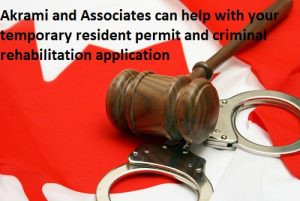Criminal Inadmissibility
The Canadian immigration officers are often vigilant when it comes to accessing a foreign national’s admissibility. They tend to scrutinize every foreign national to ensure security of every Canadian citizen and permanent resident. That being said, if you, as a foreign national, have a criminal record, you can be denied entry to Canada. If you are traveling to Canada for business or leisure purposes, your inadmissibility can have a negative impact on you, your friends, family, or even your employment. Have you ever wondered if you can overcome your inadmissibility to Canada? If so, you will learn about temporary resident permit (TRP) and criminal rehabilitation, in this blog post.
What is a Temporary Resident Permit
A temporary resident permit is a document that permits individuals, who are inadmissible to Canada due to health or criminality issues, to enter or stay in Canada temporarily. A temporary resident permit is not subject to a certain time frame in relation to the completion of the sentence. In fact, an individual can be granted a TRP while still serving his or her sentence. The validity of the TRP is at the discretion of the officer who is reviewing the application; it can be valid for a day up to a year.
How do I Apply for a Temporary Resident Permit
You can apply for a temporary resident permit at the consulate or at the port of entry. Please note, the port of entry application is only available to U.S. citizens and permanent residents. The primary advantage of applying at the port of entry is the speed with which an individual can acquire a TRP. Usually, it takes eight to twelve months to get a decision from the consulate, whereas it takes just a few minutes to get a decision at the port of entry. However, the major disadvantage of a port of entry application is the uncertainty. You never know whether or not your application will be approved by the immigration officer reviewing the application. If your application gets refused at the port of entry, all of your plans in Canada will be postponed or cancelled.
When an immigration officer is reviewing your application, he or she will determine whether or not your need to enter Canada is justifiable. On top of that, the immigration officer will ensure your presence in Canada will not pose any risk to public safety. That being said, you need to submit strong supporting documents explaining the reason behind your inadmissibility, and relevant evidence to prove your reason for coming to Canada is justified.
What is Criminal Rehabilitation
Criminal rehabilitation allows you to overcome your criminal inadmissibility on a permanent basis. Having criminal rehabilitation means that you, who had a criminal conviction in the past, no longer pose a potential risk to Canada’s public safety. If you want to be deemed admissible to Canada permanently, then criminal rehabilitation may be the option for you
There are two forms of Criminal Rehabilitation:
- Deemed rehabilitation
- Individual rehabilitation
The major difference between the two is that a person must apply for individual rehabilitation, whereas a person does not need to apply for deemed rehabilitation. Deemed Rehabilitation is automatically granted if sufficient time has elapsed since the completion of all sentences.
How Do I Apply for Criminal Rehabilitation
Canadian Criminal Rehabilitation can be a tricky matter, as there are two forms of it.
For deemed rehabilitation, the crime on your record must be the only one and must be a crime, if committed in Canada, would result in a penalty with a maximum prison sentence of less than 10 years.If this is the case for you, then you will automatically receive deemed rehabilitation 10 years after completing all the required sentences.
Individual rehabilitation, compared to deemed rehabilitation, is a bit more complicated. Eligible applicants must apply for this form of rehabilitation; it cannot be automatically granted. In order to be eligible to apply for individual rehabilitation, 5 years must have passed since the completion of your sentences. You must include court dockets detailing the circumstances of all your offences in your application. You are also required to provide fingerprint-based background checks. Apart from the documents related to your offence and your criminal record, you must also demonstrate your remorse and regret in your application. That being said, you will need to provide strong evidence to persuade an immigration officer that you have matured into a productive, law-abiding citizen, and you have not committed any further offence since your latest offence.
Along with your criminal rehabilitation application, you must submit the processing fee. The application fee for non-serious criminality is $200 CAD; the fee increases to $1000 CAD for serious criminality.
Contact Akrami and Associates
The rules set by the Canadian government are very strict when it comes to assessing a foreign national’s inadmissibility. Having to prepare all the required documents can be very confusing and exhausting. If you want to apply for a Temporary Resident Permit or Criminal Rehabilitation, it is essential to note that these applications are difficult to pursue on your own. Therefore, it is highly recommended that you seek out professional and experienced help prior to submitting the application. Akrami & Associates work and have experience with many different immigration matters. We have helped many of our clients create strong Temporary Resident Permit and Criminal Rehabilitation applications. Please feel free to contact Akrami & Associates at 416-477-2545 for more information, or if you would like to book a consultation with an immigration professional for more advice.
With Akrami & Associates, there is always a way!

